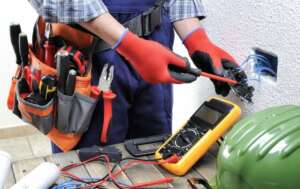Electrical work is a dangerous job. To avoid accidents, many electricians have tools that they need to cover up with a plastic bag or other protective covering during the day. This can be a hassle, but it is essential for safety reasons. With all of the different electrical jobs, electricians must know which tools they need and what type of coverings are appropriate for each task. This article will discuss why covering your electrical tool kit is so important and some things you should keep in mind as you go about choosing your coverings.
In this post, you will learn about the importance of covering your electrical tools and tips on choosing the right insurance for your Electrician business.
The Importance of Covering Your Electrical Tools
- Why It Is Important to Cover Electrician’s Tools
- Types of Kits and Covers
- Tips When Choosing Insurance Coverage for Your Tools
- Electrical Tools That Electricians Use
Electricians’ kits that they need to put in a protective bag or another covering during the day can be a hassle. Still, it’s an essential factor for safety! With all of the various kinds of jobs out there, electricians need to know which tools they should choose from their kit and what kind of covers are appropriate for each task!
Electricians should use protective covering on their electrician’s tools. This can be a hassle, but it is crucial for safety reasons. There are many types of electrical kits an electrician needs to put in coverings during the day. Everyone must know what kind of covers they need and which tool kit they should choose from when working around electricity! Please remember these tips if you’re trying to find insurance coverage for your tools!
Types Of Kits And Covers
An electrician’s kit is vital to cover up with protective baggings. It can be a hassle, but it is necessary for safety reasons. There are many different electrical jobs, so an electrician must know which tools they need and what kind of covers should go on each task! Please remember these tips if you’re trying to find insurance coverage for your devices!
Tips When Choosing Insurance Coverage For Your Tools
- Don’t forget to cover the cord if your tool doesn’t already come with its protective covering!
- It is essential that you check with your insurance provider before buying a specific type of bag for your electrician’s tools. Some plans might not cover some covers, so it’s best to double-check first!
- Be sure to check with your insurance provider to see what kind of damage is covered under your policy. Some packages cover all types, but some only offer protection against certain damages that might occur!
- If you carry your electrician’s tools on you during the day, be sure to check with your insurance provider before buying a specific type of bag for them! Some plans might not cover some covers, so it’s best to double-check first.
Electrical Tools That Electricians Use
- Pliers – Pliers are one of the most critical tools for electricians. It has many different kinds, including tongue and groove pliers, needle nose pliers, linesman pliers, and diagonal cutting pliers. Who can use pliers to twist or bend wires and cut them, and grip onto objects tightly!
- Snips – Snips is a tool that consists of two handles at right angles which contain blades with smooth sharp inside edges (cutting blade). The snips help in creating cuts by applying pressure on both handles together while keeping it straight so that edge passes through the material smoothly without any resistance
- Cable Cutter – Cable cutter is known as lineman’s side cutting plier, which comprises anvils on each jaw and cutting blade on the inside of one jaw. Cable cutter is used for making cuts to cables and wires, stripping insulation from wired) Screwdrivers -Screwdriver comes in different types, including a hexagonal head screwdriver, Phillips screwdriver, Torx head screwdrivers, etc. It consists of metal shafts attached with grips made of plastic or rubber materials with steel tips/bits fitted into recesses at the end tip. These screws may be slotted or cross-shaped heads or require special bits.
- Socket Wrench – Socket wrenches consist of an adjustable handle connected to the socket by a ratcheting mechanism used for holding nuts & bolts securely while turning them off their threaded fastener counterparts (nuts & bolts). Socket wrenches can be designed either as open-ended wrench sets (with single size fits all), like 12 point box end wrench or with multiple size wrenches.
- Wire Stripper – The wire stripping machine has an adjustable blade that helps cut through wire insulation by rotating the handle. It consists of numbers marked on it from 0 to 40. The number indicates the thickness of wire insulated copper conductor inside cable sheathing usually measured in thousandths of inches/millimetre based on American Wire Gauge standards.
- Measuring Tape – Measuring tape or measuring stick is a thin, flexible ruler with markings for making measurements. It is widely used in construction and carpentry applications to measure the distance/length of objects.
- Torpedo Level – Torpedo levels consist of two vials (bubble vial & spirit level), one at each end, as well as a small metal bar connected between top plates facing upward towards the user’s hand holding torpedo level. The vials are used to check for flatness or plumb and the status of a surface.
- Pneumatic Staple Gun – Pneumatic stapler, as the name suggests, uses compressed air from either portable compressor or gas cartridge attached to its body through a hosepipe, which helps drive staples into materials needed without using hands, unlike manual one. Pneumatic nailers have been designed with a depth adjustment screw to change moving depth, belt clip, etc.
- Flashlight – Flashlights are handheld lamp devices consisting of a small electric light bulb mounted inside a cylindrical housing with a switch.

In Conclusion, electrical tools play a vital role in the field of electrical wiring. They help electricians to complete their jobs efficiently and quickly without any hassles. Your work will be safe and backed by a warranty only if you use them properly & cover them before putting them away or packing up for the next job!
I hope this article gives you some idea about the importance of covering your electrical toolset after working on it! Please contact the experts at All Trades Cover and find the right option for covering your tools today.


